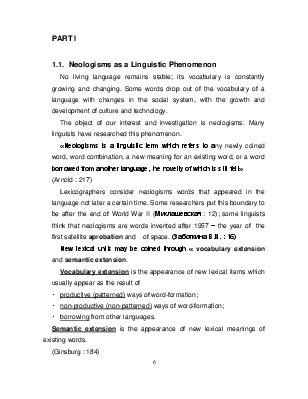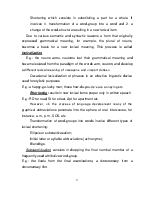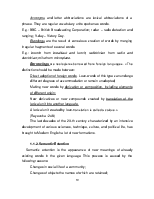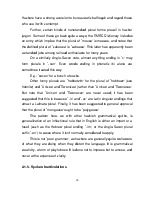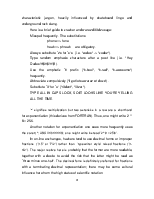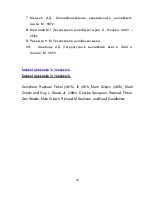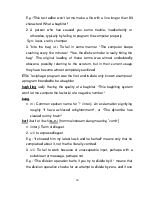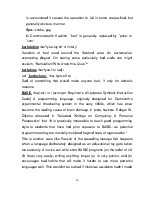Міністерство освіти України
Кафедра лексикології та стилістики англійської мови
ДИПЛОМНА РОБОТА
Лексичні та синтактико-стилістичні
зміни в сучасній англійській мові:
вплив комп’ютерних технологій
Студентки групи
факультету
Науковий керівник:
Київ-2000
Ministry
of Education in Ukraine
Department of English Lexicology and Stylistics
Diploma Paper
Lexical and Syntactic-Stylistic Changes
in Modern English Language:
Computerization, Impact
Scientific advisor
Kyiv 2000
Table
of contents
Introduction…………………………………………………………………...3
Part I
1.1. Neologisms as a Linguistic
Phenomenon
1.1.1. Vocabulary Extension
1.1.2. Semantic Extension
1.2. Stylistic Classification of the
English Word-Stock
1.2.1.The Notion of Slang, Jargon, and Techspeak.
1.2.2.Hackerdom
1.2.3.Hacker
subcultures
Part II
2.1. Jargon
Construction
2.1.1.
Verb Doubling
2.1.2.
Soundalike Slang
2.1.3.
The «P» convention
2.1.4.
Generalization
2.1.5.
Spoken Inarticulations
2.1.6.
Anthropomorphization
2.1.7.
Comparatives
2.2. Hacker
Style as
2.2.1.
Hacker Speech Style………………………………...
2.2.2.
Hacker Writing Style……………………………………….
2.2.3.
International Style……………………..…………………….
2.2.6.
Hacker Humour
2.3.
Pronunciation Features of Hacker Jargon
Conclusions……………………………………………………………….55
Bibliography……………………………………………………………..
56
List
of Lexicographical Sourses
List
of Internet Sites
Glossary
of Terms……………………………………………………….55
Appendix………………………………………………………………….57
INTRODUCTION
This paper deals
with computerization as a source of lexical, syntactic-stylistic, and phonetic
changes in Modern English language. It focuses on hacker’s jargon having its
construction, stylistic peculiarities, and phonetic features as the target.
The scientific novelty of the paper lies in the attempt to systemize
lexical, syntactic-stylistic, and phonetic changes, which are introduced by
hacker culture to Modern English; to find out and describe particular features
of hacker jargon; to analyse the correlation between basic hacker
subcultures. A few hackers tried to analyze the language they use; the problem
of hacker’s jargon is still a moot point.
The theoretical value of the research lies in the fact that it is one
of the first attempts to investigate the changes introduced to Modern English
with the appearance of computers. We hope that the obtained data will make a
contribution to the linguistic studies, especially to the pragmatic aspects of
linguistics.
The practical value of the work is in the opportunity to apply the data to the process of
teaching English at university: to teach conversational English at practical
English classes, at lectures on English Lexicology or Stylistics.
The objective of the paper is to reveal and describe a set of
lexicological, stylistic, and phonetic features of hacker jargon.
In accordance with
the objective the following tasks are set:
1) to define the status of hacker jargon as a
linguistic and sociocultural phenomenon;
2) to single out and analyze the most
significant ways of forming hacker jargon;
3) to analyze the style hackers use in written
and oral speech;
4) to provide pronunciation keys to the
jargon.
The investigation was carried out on the
material of Internet. 25 sites in total introducing the peculiarities of hacker
jargon were analyzed through the use of diachronic, synchronic, descriptive
approaches, through some elements of distributional, substitution, and
oppositional methods of linguistic analysis and with some elements of
conceptual, linguostylistic, and sociocultural analyses included.
The structure of the work is donein
accordance with the general conceptual framework adopted. Part I of the paper
dwells upon neologisms as a linguistic phenomenon, stylistic differentiation of
Modern English vocabulary, the difference between slang, jargon, and techspeak,
and hacker culture as a loosely networked collection of subcultures. Part II
presents tentative applications of basic approaches to hacker jargon analysis
in terms of linguistics, semantics, stylistics, and phonetics. Conclusions contain
the description of the major results of the research.
PART I
1.1. Neologisms as a Linguistic Phenomenon
No living language remains stable; its
vocabulary is constantly growing and changing. Some words drop out of the
vocabulary of a language with changes in the social system, with the growth and
development of culture and technology.
The object of our interest and
investigation is neologisms. Many linguists have researched this phenomenon.
«Neologisms is a linguistic term which
refers to any newly coined word, word combination, a new meaning for an
existing word, or a word borrowed from another language, the novelty of which
is still felt»
(Arnold : 217)
Lexicographers consider neologisms words
that appeared in the language not later a certain time. Some researchers put
this boundary to be after the end of World War II (Миклашевская : 12); some linguists think that neologisms
are words invented after 1957 – the year of the first satellite aprobation
and of space. (Заботкина В.И.
: 16)
New lexical units may be coined through « vocabulary extension
and semantic extension.
Vocabulary extension is the appearance of new lexical items which usually appear as the
result of
· productive (patterned) ways of word-formation;
· non-productive (non-patterned) ways of word-formation;
· borrowing from other languages.
Semantic extension is the appearance of new lexical meanings of
existing words.
(Ginsburg :
184)
1.1.1. Vocabulary Extension
Neologisms
are usually coined out of elements, which already exist in Modern English.
Deliberate coinage is mostly the product of one’s creativity, ingenuity, and
imitation. One should distinguish between patterned
and non-patterned ways





